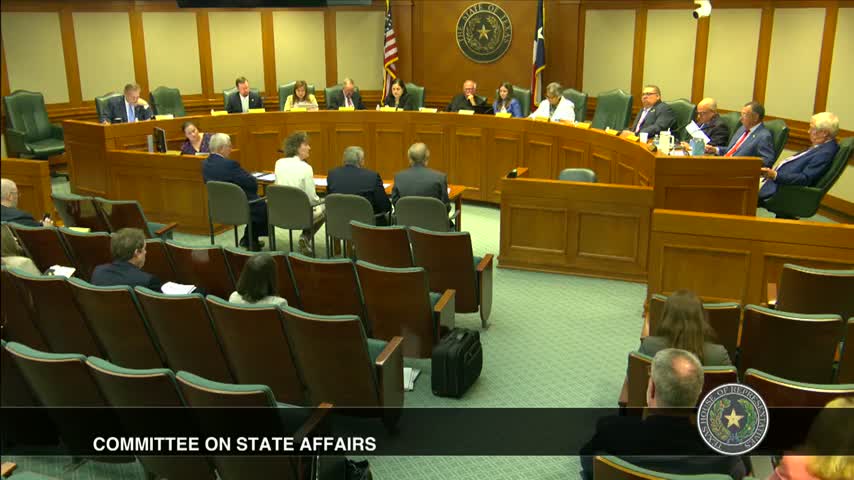Texas Insurance Crisis Sparks Urgent Calls for Reform
August 16, 2024 | Committee on State Affairs, HOUSE OF REPRESENTATIVES, Legislative, Texas
This article was created by AI summarizing key points discussed. AI makes mistakes, so for full details and context, please refer to the video of the full meeting. Please report any errors so we can fix them. Report an error »

During a recent government meeting, significant discussions emerged regarding the financial challenges facing the Texas Windstorm Insurance Association (TWIA) and the broader implications for coastal communities and the state's economy.
One key point raised was the dramatic increase in TWIA's reinsurance costs, which have surged from $100 million four years ago to $380 million today. This escalation reflects a broader trend, with the rate online—the percentage paid for coverage—rising from 5% to 9%. As a result, TWIA policyholders are effectively paying 80% more for the same coverage. The probable maximum loss (PML) also saw a sharp increase, necessitating an additional $2 billion in reinsurance coverage, which translates to nearly $200 million in increased costs for ratepayers.
Charlie Zahn, chairman of the Coastal Wind Storm Task Force, emphasized the need for a fair and equitable funding solution for TWIA, highlighting the importance of addressing the debt burden on premium payers. He proposed increasing the Coastal Resilience Trust Fund (CRTF) to $1 billion, suggesting that this could be achieved through the state's rainy day fund or short-term loans. Zahn also advocated for a one-time statewide assessment on all insurance policies to cover potential losses, contingent on the occurrence of significant weather events.
Sally Baco, director of policy and government relations for the city of Galveston, pointed out that the current funding structure for TWIA is unsustainable. She noted that the Texas Sunset Commission had identified critical issues, including the conflicting mandates of TWIA as both an independent insurer needing higher rates and as an insurer of last resort requiring affordable rates for vulnerable policyholders. Baco suggested several reforms, including improving building codes, enhancing competition in the private insurance market, and reducing administrative costs.
The discussions underscored the urgent need for a comprehensive review of TWIA's funding mechanisms and operational strategies to ensure the long-term viability of windstorm insurance in Texas, particularly for coastal residents who rely on these policies for protection against natural disasters.
One key point raised was the dramatic increase in TWIA's reinsurance costs, which have surged from $100 million four years ago to $380 million today. This escalation reflects a broader trend, with the rate online—the percentage paid for coverage—rising from 5% to 9%. As a result, TWIA policyholders are effectively paying 80% more for the same coverage. The probable maximum loss (PML) also saw a sharp increase, necessitating an additional $2 billion in reinsurance coverage, which translates to nearly $200 million in increased costs for ratepayers.
Charlie Zahn, chairman of the Coastal Wind Storm Task Force, emphasized the need for a fair and equitable funding solution for TWIA, highlighting the importance of addressing the debt burden on premium payers. He proposed increasing the Coastal Resilience Trust Fund (CRTF) to $1 billion, suggesting that this could be achieved through the state's rainy day fund or short-term loans. Zahn also advocated for a one-time statewide assessment on all insurance policies to cover potential losses, contingent on the occurrence of significant weather events.
Sally Baco, director of policy and government relations for the city of Galveston, pointed out that the current funding structure for TWIA is unsustainable. She noted that the Texas Sunset Commission had identified critical issues, including the conflicting mandates of TWIA as both an independent insurer needing higher rates and as an insurer of last resort requiring affordable rates for vulnerable policyholders. Baco suggested several reforms, including improving building codes, enhancing competition in the private insurance market, and reducing administrative costs.
The discussions underscored the urgent need for a comprehensive review of TWIA's funding mechanisms and operational strategies to ensure the long-term viability of windstorm insurance in Texas, particularly for coastal residents who rely on these policies for protection against natural disasters.
View full meeting
This article is based on a recent meeting—watch the full video and explore the complete transcript for deeper insights into the discussion.
View full meeting
